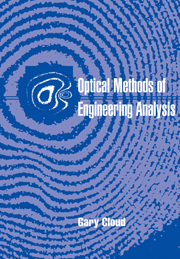Book contents
- Frontmatter
- Contents
- Acknowledgments
- 1 Introduction and orientation
- Part I Optics and interferometry
- 2 Light and interference
- 3 Classical interferometry
- Part II Photoelasticity
- Part III Geometrical moire
- Part IV Diffraction theory, optical processing, and moire
- Part V Moire interferometry
- Part VI Holographic interferometry
- Part VII Speckle methods
- Author index
- Subject index
3 - Classical interferometry
Published online by Cambridge University Press: 12 January 2010
- Frontmatter
- Contents
- Acknowledgments
- 1 Introduction and orientation
- Part I Optics and interferometry
- 2 Light and interference
- 3 Classical interferometry
- Part II Photoelasticity
- Part III Geometrical moire
- Part IV Diffraction theory, optical processing, and moire
- Part V Moire interferometry
- Part VI Holographic interferometry
- Part VII Speckle methods
- Author index
- Subject index
Summary
Some examples of so-called classical interferometric techniques are described in this brief chapter. Also included is a discussion of laser Doppler interferometry, which is fundamentally different from the other methods discussed in this book, but which has matured into an extremely useful approach for dynamic measurement.
Newton's rings
One of the oldest and most easily observed of interferometric phenomena is the formation of interference fringes in thin films. Apparently, they were first described scientifically by Boyle and Hooke, but they are named after Newton because he first analyzed their properties. This type of interference is responsible for the colors observed in an oil slick. It causes troublesome spurious fringes when one photoplate is contact copied onto another and when glass cover plates are used to protect your favorite 35-mm slide. On the other hand, Newton's rings provide an easy way of checking for full contact between two surfaces, as when an optical flat is used to check the flatness of a finely lapped surface. A similar process accounts for the functioning of dielectric interference filters that are used to isolate a narrow band of wavelengths from a beam of light. In fracture mechanics research, Newton's rings have been used for measuring the opening of cracks in transparent materials.
Analysis of the formation of Newton's rings in the general case (Born and Wolf 1975; Tolansky 1973) is not as simple as might be thought. Only the most basic case is discussed here, as the purpose is primarily one of example.
This type of interferometry is classed as amplitude division because each wave train of light is divided into two parts that are subsequently recombined.
- Type
- Chapter
- Information
- Optical Methods of Engineering Analysis , pp. 40 - 54Publisher: Cambridge University PressPrint publication year: 1995

